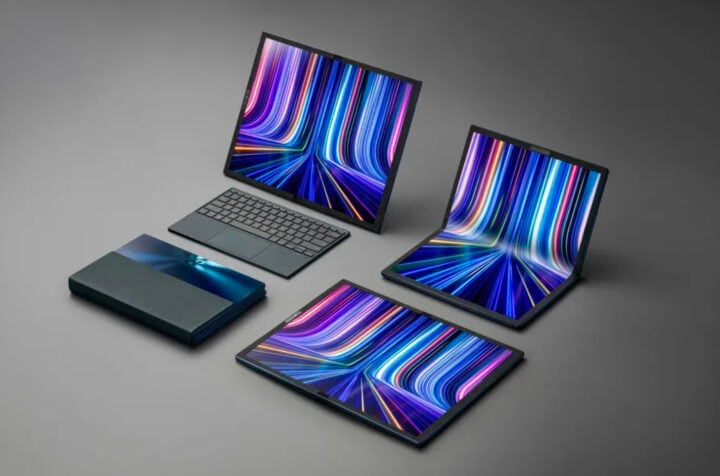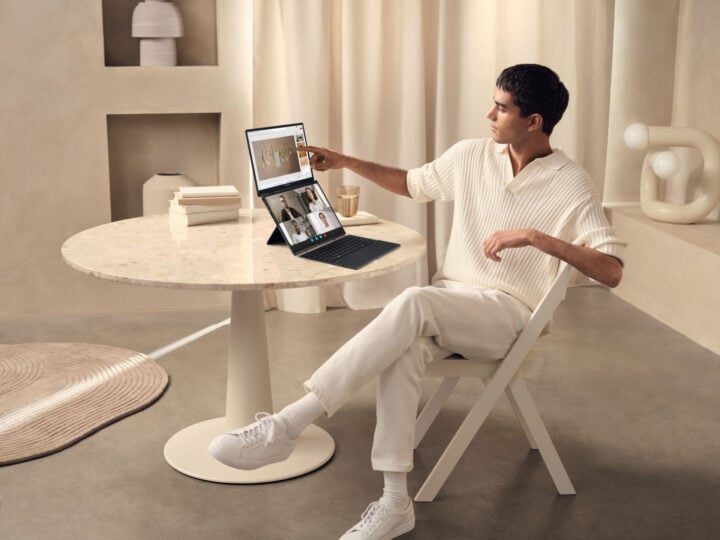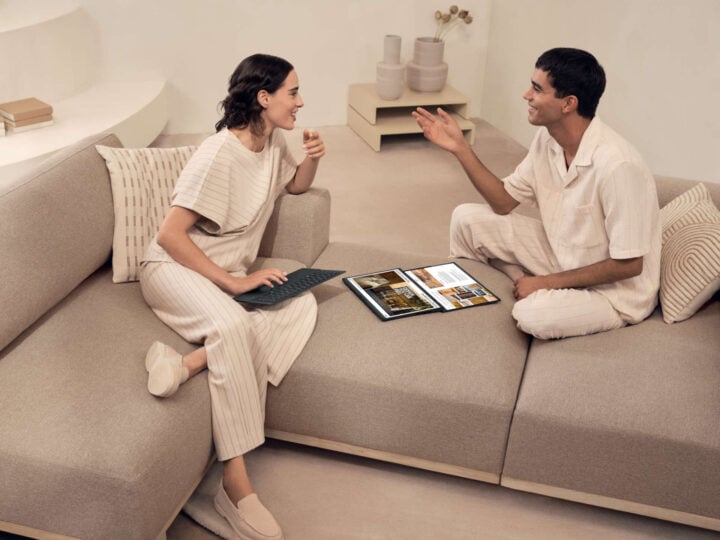
For as long as laptops have been around, portability has been the name of the game. But traditionally, that’s meant repeating the same formula: one screen, a keyboard, and sacrificing screen space. The Asus Zenbook Duo defies convention with a fully-fledged dual-screen laptop, bringing the stuff of sci-fi movies to the masses.
Multi-display PCs are no longer a convenience confined to the desk. By turning old ways of working on its head, the Zenbook Duo combines two full-sized screens into one convenient device. Through multiple iterations, Asus’s laptop brings a sci-fi-like aesthetic to a practical device perfect for multitaskers who want convenience wherever they go.
Unlike many devices that promise a taste of the future, only to never release or not live up to lofty promises, the Zenbook Duo is a rare gadget that achieves what it sets out to do. Not only is it fun to use, while others look on enviously with single-screen laptops, but it’s also highly practical. That’s not something many futuristic-looking gadgets can claim.
In the beginning
Asus’s attempts at adding a second screen to the humble clamshell laptop have taken on various forms over the years. Smaller screens and foldable displays — there were a few different designs before finding the ideal solution.
Under the Zenbook Pro 14 Duo name, one iteration saw a smaller secondary screen sit atop a compressed keyboard. Praised at the time for being “perhaps the ultimate notebook for habitual multitaskers”, it was aimed at creatives who wanted quick access to touch controls while making the most of the main display.
Alongside the more conventional approach, Asus also produced the Zenbook 17 Fold. A whopping big laptop-tablet hybrid, it used a folding screen technology similar to that used by foldable phones.

Usable as a clamshell laptop, a giant tablet, or a standalone portable display connected to a wireless keyboard, the Zenbook Fold stood out in a crowd. It paved the way for dual-screen laptops: a device for people who need more screen space than traditional laptops provide, and a large display without needing a separate purchase.
It ultimately served as the blueprint for the modern Zenbook Duo. Instead of a foldable screen, the revised laptop went to two full-sized OLED displays, ensuring it was both practical and cost-effective.
A current-day Zenbook Duo
When Asus debuted the modern Zenbook Duo design in 2024, it transformed dual-screen laptops from novelty to practicality. Multiple screens were no longer a sci-fi fantasy or a gimmick; they became good enough to accompany everyday workflows.
As GadgetGuy Editor Chris Button put it in his review of the 2024 model, “two screens are better than one”. Dubbed a “multitasker’s dream”, this version of the Asus Zenbook Duo paired its twin screens with an Intel Core Ultra chip for impressively smooth performance. It breezed through work tasks and even surprised with its capable gaming prowess.
It confirmed that dual-screen laptops aren’t a fad: they genuinely bolster the workflow of anyone accustomed to multi-display desktop setups. Having desktop-level convenience with the portability of a laptop is a powerful thing.
Since then, Asus decided to continue with a winning formula, powering up the internals for the upgraded model. The latest Zenbook Duo sports an Intel Core Ultra 9 (285H) processor, making the laptop capable of faster processing speeds and smoother overall performance.

For those with the latest gadgets, including top-of-the-line networking gear, the updated Zenbook Duo connects faster and more efficiently. With the latest Wi-Fi 7 and Bluetooth 5.4 wireless technologies, files transmit faster and video calls run smoother, leaving you with more time to get things done.
You can’t look at the Zenbook Duo without mentioning the headline act: its displays. Both screens are full 14-inch OLED displays capable of rendering sharp 3K visuals. With this versatility at your fingertips, every airport lounge, café, and library becomes a haven for creativity and productivity.
Importantly for digital creators, each screen supports stylus input using the included Asus Pen. Digital illustrators and designers can create with cinema-grade precision, thanks to each screen’s 100% DCI-P3 colour accuracy.
It’s remarkable to think that the Zenbook Duo today is faster, more practical, and more affordable than previous attempts at dual-screen laptops.
It’s a laptop, tablet, and portable monitor all in one
What’s under the hood is impressive, but the Asus Zenbook Duo reaches its full potential through versatility. As mentioned before, its touchscreens give the laptop tablet-like functionality. But that’s only one of many hats Asus’ laptop wears.
Equipped with four modes, the Zenbook Duo doesn’t conform to the limitations posed by old-school laptops. That being said, if you ever just need a traditional clamshell laptop, it can do just that. Attaching the included keyboard to the bottom screen instantly adjusts the device to a single-screen setup, handy for when space is limited.
Dual Screen Mode does what it says on the tin, giving you full access to both 14-inch displays. Handily, there’s a bit of flexibility on offer. You can place the laptop on a surface, like your lap, and use both screens independently or as one big screen.
Alternatively, the Zenbook Duo’s built-in sturdy kickstand elevates the screens to eye-level, as if you stacked two monitors on top of one another. Regardless of the setup, the laptop cleverly manages your windows accordingly, ensuring each screen shows your content naturally.

Turning the Duo on its side like a book enables Desktop Mode. It’s ideal for working on projects that benefit from seeing lots of information aligned vertically. For example, Desktop Mode fits more of an article, PDF, or coding screen without scrolling than a landscape view. Want to fit in as much information at a glance as humanly possible? This is the way to go.
Finally, there’s Sharing Mode. It employs the Zenbook Duo’s 180-degree hinge, laying completely flat, providing an easy-to-see view for anyone sitting at the same table. Ideal for meetings, it saves awkwardly passing a laptop back and forth. If there are two of you sitting across from each other, you can also set the content of one display to rotate and face the other person.
While other laptops continue to do the same thing, Asus shows that laptops with multiple displays aren’t some far-off abstract concept. They’re here now, and the Zenbook Duo proves that there’s still room for laptops to innovate on exciting sci-fi-inspired ideas.
The post How the Asus Zenbook Duo is sci-fi technology brought to life appeared first on GadgetGuy.



0 (mga) komento:
Mag-post ng isang Komento